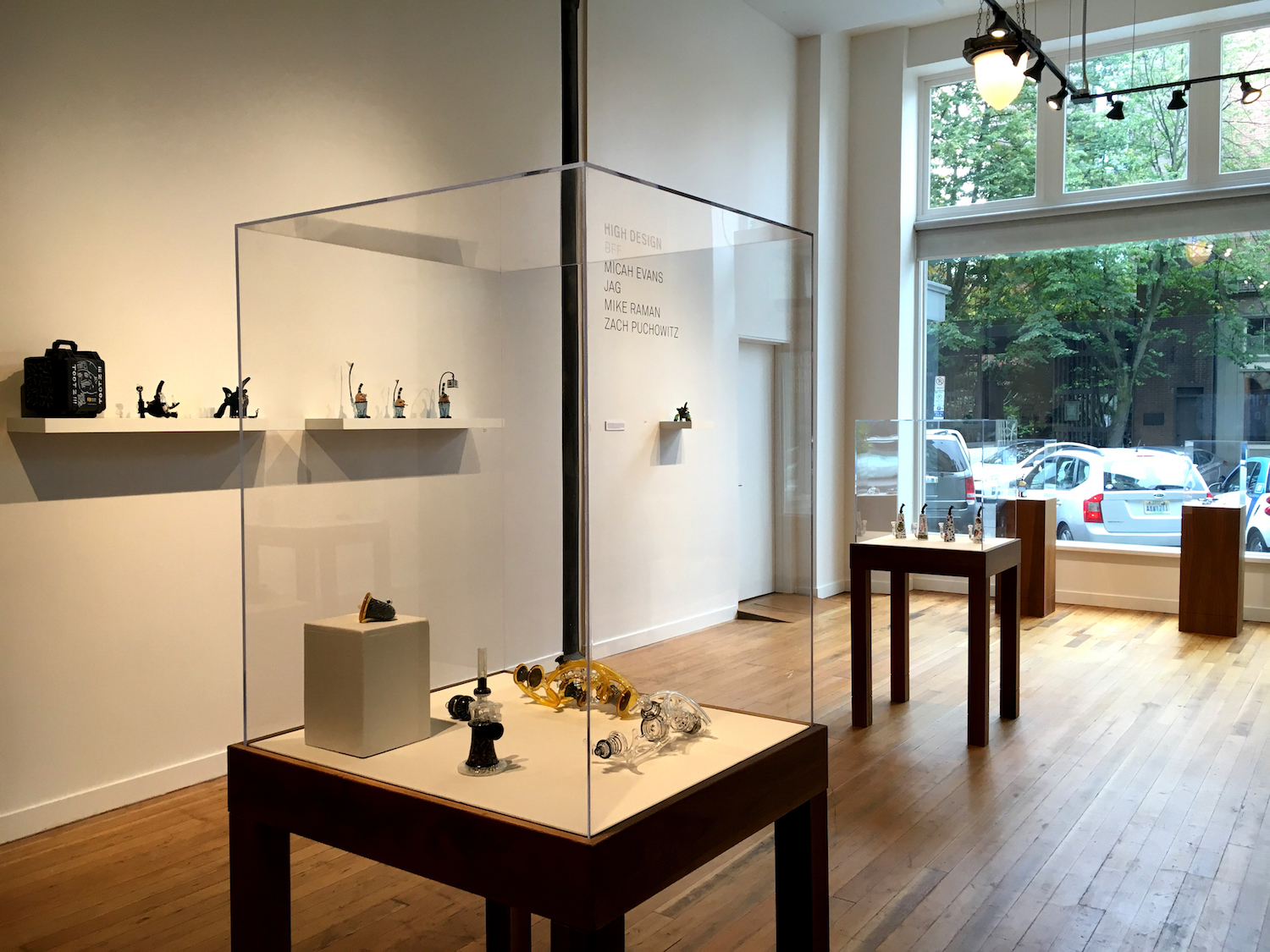The cleverly-titled exhibition "High Design," on view at the Pilchuck Glass School's Seattle exhibition space through September 29, 2016, showcases the work of five glass pipemakers who are some of the best-known figures in a subculture of functional flameworking that is seeing increasing engagement with the larger glass art world. The exhibition was spurred by two factors. First was a 2012 ballot initiative to legalize the recreational use of marijuana, which removed some of the legal shadows that kept pipemaking officially or unofficially off-limits for many glass programs. The other was the personal initiative of Pilchuck artistic director Tina Aufiero, who has challenged the rejection of glass pipes, and even offered a class — “C’est une Pipe” — at the most recent summer sessions at the Stanwood, Washington, program that openly taught techniques for making marijuana paraphernalia from glass.
“People have been making pipes in these classes since there have been flame classes on the Pilchuck campus," Aufiero told the GLASS Quarterly Hot Sheet in a telephone interview. "And there’s one new class this summer that had the word ‘pipe’ in it. Have there been other pipe classes on campus? Absolutely. It’s a game of semantics… Everybody in flame classes makes pipes. But do they show them? No! They hide them. Pot became legal here [in Washington state], and they were still hiding their pipes. So I started to say, ‘Okay, I know you worked until 3 AM, just leave the freakin’ pipes out. I don’t care — I can see them, it’s okay. I’m not judging you.’”
The 26 works in the exhibition on view in Seattle features work by glass artists Micah Evans, BFF, Zach Puchowitz, JAG, and Mike Raman. All produced functional glass pipes between 6- and 12-inches tall. Pilchuck exhibition assistant Lydia Boss said in an email exchange with the Hot Sheet that “a lot of the works featured were made by the artists specifically for our show. I think you can feel that when you come into the gallery.” The gallery has been specifically laid out to emphasize the “sculptural and visual properties of each piece,” Boss said. “When putting together this group of artists, Tina Aufiero and I did a lot of research. We wanted to feature artists who work within a very considered aesthetic… Although the five artists all have their own styles, their work complements each other in the sense that each piece is incredibly detail oriented and aesthetically beautiful.”

Despite their aesthetic beauty, these objects have been just as controversial within the glass art community as they have been within the culture at large, and their presentation at the Pilchuck gallery space is significant. In the early 2000s, a major federal crackdown on glass pipe makers was accompanied by several glass art schools instituting policies to ban pipemaking. Students interested in making pipes were viewed as rowdy, and Studio Glass artists, themselves eager to escape “subculture” status, have historically been less than sympathetic to artists working in the form. In her 2014 GLASS Quarterly feature article (GLASS #136, Fall 2014), Susie J. Silbert wrote that, “if glass is the redheaded stepchild of fine art, then pipes are the glass art world’s black sheep.” But changing laws and sentiments in the past five years are turning the story around. Recreational marijuana use became legal in Colorado and Washington in 2012, with the country’s first retail marijuana store opening in 2014. Oregon has since followed suit, voting for legalization on a ballot measure in July of 2015.

According to Aufiero, “High Design” was conceived partly as a way to discuss this legal change in the state and embrace the subculture of pipemakers. “If anything, Pilchuck should be the place that says, ‘Okay, this is okay,’” she said. “We want people to make work at Pilchuck; we want busy hands and happy hands. And that’s what we’re going for here — to support a community here, any community that wants to work with glass.” Boss echoed this sentiment, stating that “this show is really about bringing pipe makers and Pilchuck together; embracing the borosilicate community while featuring work that is both functional and alluring.”
But the other impetus for the show is the sheer quality of the work on display. The pipemakers “were particularly picked because of their excellence,” Aufiero told us. “The show is about the aesthetics of the objects… and it’s just so elegant. The gallery looks so good. It really shows the work off as an object of art.” From the swooping sophistication of Micah Evans’ pipes, to Zach Puchowitz’s polished depictions of grungy urban culture, the show has a range of aesthetically accomplished work to show.
.jpg)
Will pipes continue to be seen as an increasingly legitimate art form? Aufiero thinks so, “just like the way we revere beautiful old tobacco pipes and their craftsmanship and how they were made… The skills you can see are incredible. The craftsmanship on these objects — not everyone can do this. It’s like a goblet maker: the best of the best. You have the skills and hands that not everybody has. We’re celebrating that with this show. And this group of people not only has an incredible set of hands, but they have an incredible eye for design and detail and object, as if it were any kind of object for beauty. It just happens to have a function.”
IF YOU GO:
Micah Evans, BFF, Zach Puchowitz, JAG, and Mike Raman“High Design”
Through September 29th, 2016
Pilchuck Exhibition Space
240 2nd Ave S, #100
Seattle, Washington 98104
Tel.: 206 621 8422
Website







